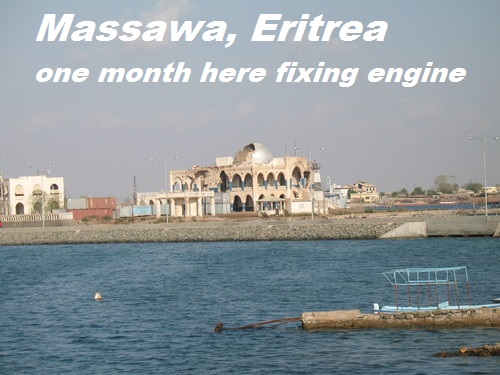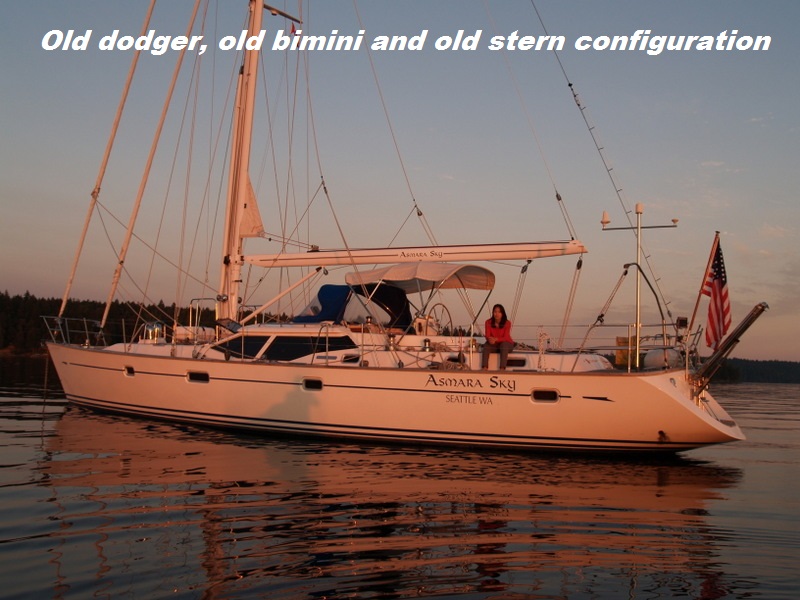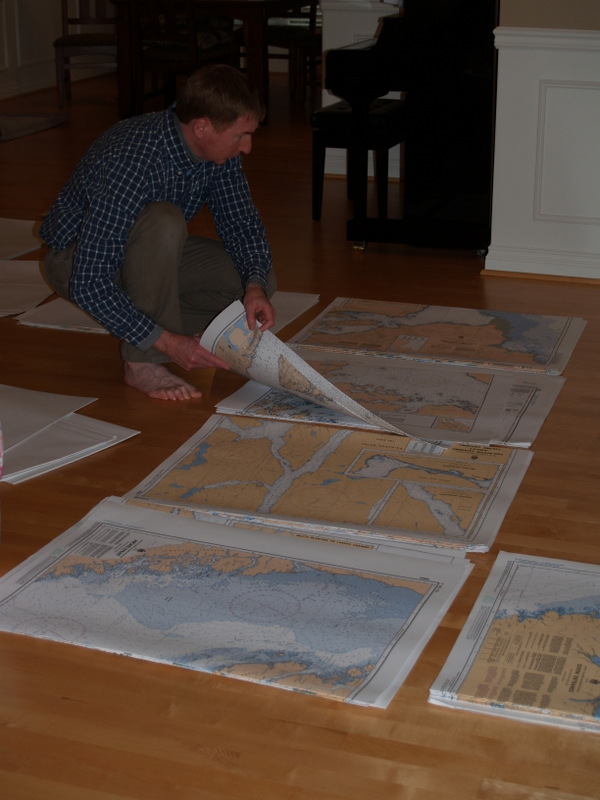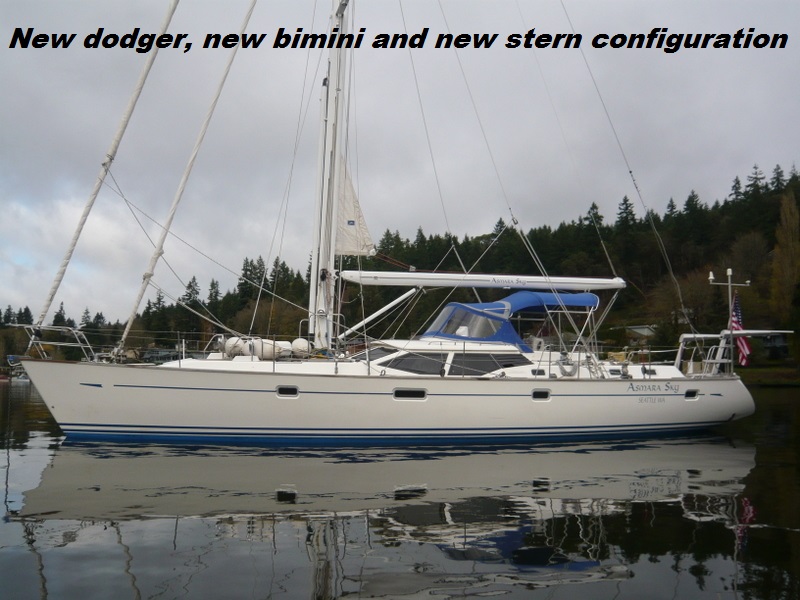- Boat
- Articles
- About
- Tehani-li Logs
- 2004
- Uligan Maldives
- Man, Oh Man, Oman
- Eritrea: The Nicest Place You’ve Never Heard Of
- Cruising Notes: Oman to Eritrea – From Pirates to Cappucinos
- Old Testament Sudan
- Egypt: Legend, Myth and Reality
- Thoughts on Cruising the Red Sea
- Greece: Civilization Again
- Montenegro
- Malta
- Sardinia, Italy
- Barcelona, Spain
- 2003
- 2002
- 2001
- 2004
- Contact
Time & Money

“And you run and you run
To catch up with the sun
But it’s sinking
Racing around
To come up behind you again” – Time, Pink Floyd
Today I dropped my daughter off at pre-school and her teacher, asked me, “Off to Alaska soon, right?” When I nodded and told him we leave in June and that I was on my way to the boat to do some work he was surprised, “Work? What work? Don’t you just sail off and enjoy yourselves?”
Hmmm. Those of us who own boats and use them know how far from the truth that idea is. The rest of the population, i.e., EVERYBODY else really has no concept of what needs to be done to make voyaging reality. Two things in almost limitless abundance are required: time and money.
Mounting small instruments requires agility
Time is a killer because everything just takes so much longer to get right on a boat than it does in a house or a car. Just this morning I tried to mount the new barometer (nothing perverted here; I tried to find a place to stick it, the barometer that is). Before drilling holes in walls you need to know exactly what lurks behind so you aren’t drilling into wires, hoses or garden gnomes. I thought I had found the perfect place right above the nav station. To check what was behind that small piece of wood above the nav station required removing two ceiling panels and two wall panels. Of course, I dropped the biggest panel creating some nice and expensive dings in the wood floor. Dis-assembly without doing even more damage took over an hour.
The result of my clumsy toil was discovery of a massive conduit located right behind where I had hoped to drill. The space contained not only DC wiring but AC wiring and a hose! Just about everything went through there and it would have been a disaster if I had just drilled and hanged the damn barometer. Good to know and I made a mental note. Putting it all back together carefully took another hour. By the end of the morning I had not found the place to put the barometer and seemingly had wasted half the day. Working on boats is like that. And this was just for something as simple was a barometer. (I eventually stuck it on the wall by the mast).
Yet just to get to that glory-filled moment of barometer hanging is a very long journey. Having done gone offshore on two of my previous boats and now furiously engaged on my third time it seems to me to work out to a five part process that is an incredibly arduous obstacle course which weeds out all but those who are very determined, those who are very lucky and those who are just crazy. We put ourselves in the first group but I know friends and others really think we may just belong in the third….

In a galaxy far, far away
Aside from barometers and a mast, what else do we have on a boat that is supposed to take us to galaxies far, far away? Here are some of the systems on board our boat “Asmara Sky” that work well now and are waiting to break:
GPS
VHF radios
SSB radio
Radar
Chart plotter
AIS (“Automatic Identification System” for ships)
Depth sounder
Wind instruments
Autopilot
Windlass for raising anchor
Hydraulic furling for mainsail and genoa
Electric davits
Dinghy outboard
Main engine
Diesel generator
Propane system
Webasto heating system
Water maker
Microwave
Water pump
Sump pumps
Toilets
Navigation lights
I should point out if the microwave breaks down we dump it and find a new one. If the engine stops working we can’t follow the same procedure. Engine breakdowns could also be one of any hundred different things that come to mind. Each problem requires time and effort to discover what happened and then more time and effort to repair it. As boats by nature are very compact with a lot of “stuff” stuffed into them, just getting access to whatever is broken and vexing you can either be an exercise in gymnastics or one of demolition.

Soup to nuts: the five course meal
Part One: Having the Dream. Many people “dream of sailing away to the South Pacific, someday.” Ok, at least you have some imagination. That alone sets you apart from nine tenths of your friends. But it won’t get you any further than that.
Part Two: Saving the money. Boats are expensive and keeping them is expensive. Any boat you buy will not be perfect and will require upgrading and modifications of some sort. Nobody sells a boat in perfect working condition (because they don’t exist!). Whether you upgrade the place mats or things fundamental such as sails, rigging, electronics, anchors, dinghy, etc. etc. etc., it costs money.
Part Three: Finding and buying the boat. It took us two years of searching to find our boat. Yet, many who have got the money together often shy away at the last moment and don’t actually buy the boat they have been dreaming about and saving for. Life gets in the way, things happen or maybe priorities change. It is worth remembering here this life style is not right for everyone.
Part Four: Outfitting the boat. This is the stage we are in now. It is very painful and is a constant source of poverty inducing action. I will talk about financial suicide in detail in this post.
Part Five: Taking off. This is possibly the hardest step of all for many. Those of you in the dreaming stage may find it incredible but 99% – or more – of boat owners who make it to the final step in their quest to “sail away” fall flat here. Reality sets in: “I have to leave my job? Pack up the house? Say goodbye to family and friends? Yikes.” Any walk around a marina will reveal countless forlorn “offshore boats” looking like sad penguins in a zoo: all dressed up with nowhere to go.

Taking a sailboat around a lake or a bay for lunch means a different level of preparedness and gear than going offshore and crossing an ocean. Like the proverbial red-haired stepchild, any gear or systems on board an offshore vessel have a rough life. They are bounced around continuously, often sprayed with salt water and live in a salty humid environment. Breakdowns happen almost daily. During our last cruise from Asia to Europe with our Tayana 52, “Tehani-li,” I estimate I spent three hours or more each day just fixing things and doing maintenance to stave off the inevitable breakdown moment just a little longer.
On our last boat we ended up blowing the head gasket on the main engine, a Perkins 4-236. Bad luck but this stuff does happen to people. Worse luck for us was that it finally happened at anchor in Massawa, Eritrea – one of the poorest countries in Africa. The repair took a month – at anchor while the temperature was flirting with 100 degrees and I was only able to complete it with the selfless help of other, more knowledgeable cruisers in the anchorage (thank you again, “Free Radical” and everyone else).

“Money is better than poverty, if only for financial reasons.” – Woody Allen
You won’t even get to spend a lot of time on board fixing things unless you have money. Money to buy the boat and money to keep it – as well as money for all the parts and tools needed to keep you floating.
We purchased our boat, a 2002 model Oyster 53 two years ago. Since then the checks have not stopped: checking off our list of things to get done and writing checks for each one as we go!
Let me begin here by admitting yes, we bought an expensive boat. Therefore, everything we do to the boat – by definition – will be expensive. If you buy a less expensive boat your costs should be less but you will still have costs that will scare the bejesus out of you. It is all relative. In the interest of fair analysis, here is what we have done so far and what it cost.
Installed new life raft (Revere 6 man) in cradle on deck: $4,600
Four survival suits (Imperial): $1,064
Installed new anchor at bow (Spade S200): $1,800
Installed new VHF radio at nav station (Icom M504): $388. We have a European boat and the VHF on board did not have all the US channels…
Bought first dinghy (Caribe 9L) which proved too small: $2,600
Bought first outboard (Yamaha 15 hp) which proved too small: $3,200
Bought new dinghy with new outboard (AB AL10 + 20hp Tohatsu outboard): $13,000
New cover for new dinghy: $1,925
Two handheld VHF radios (Icom M72): $400
Replaced cockpit VHF (Icom HM-162B): $192
Spare handheld GPS: $180
Replaced all standing rigging: $16,500
Replaced all lifelines: $2,160
Replaced steering cables and chain: $995
Two new propane bottles (aluminum): $327
Changed name of boat: $800 for new decals + $100 for bottle of champagne
Replaced both pump toilets with new electric heads (Jabsco Quiet Flush) and new hoses: $1,922
5000 Watt transformer: $200. Again, with a European boat we only have 220 volt power aboard…
New raw water pump for Westerbeke generator: $535
Rebuilt old raw water pump for generator: $301
Valve job for Yanmar main engine: $164
New fresh water pump (Jabsco Dual Max): $614
Workshop vise (Wilton): $88
All kinds of tools (Craftsman wrenches, sockets, screwdrivers, DeWalt power tools): $1,500
Hauled boat, faired hull and put two coats new bottom paint on: $3,993
Removed and repaired MaxProp: $1,582
Installed Webasto Hydronic heat system: $17,295 (ouch!)
Removed hydraulic passerelle and repaired holes in transom: $1,725
Imported Simpson Davits (S8 300 kg) from UK to raise and lower dinghy: $9,451
Fabricated structural reinforcement to lazarette and installed davits: $8,088

New dodger and bimini (Iversons): $7,363
Three new custom made mattresses to fit boat: $5,683 (Wife was adamant…)
Upgraded and instaledl new electronics – ours were 10 years old and could not accommodate AIS: $11,849
Flushed and repaired on board hydraulics (mainsail and headsail furling gear): $1,622
Custom boom preventer: $1,104
Medical Kit: $1,500
Abandon Ship Bag: $600
EPIRB (ACR): $600
Two personal EPIRBs (Fast Find PLB): $504
Iridium phone subscription: $1,521
What’s the total? I don’t even know and almost don’t want to know but since we have come this far I will now add it up for the first time. I do this with some hesitation because I know it will make me feel stupid and be a bit of a shock.
Total: $130,035
Picking myself up off the floor I also must add none of the above counts what I have spent on charts ($3,000 and rising), coast pilots and guide books. Nor does it take into account engine spares, fuel, marina slip fees and insurance. The whole new wardrobe you need for offshore sailing in the Pacific Northwest soaked us for a few more thousand dollars on top of that. We also need a new suit of sails in the next year or so which will set me back another $25,000. I can barely imagine spending that much more.
Like driving across Kansas, the pain of outfitting an offshore boat and the pain we are feeling is real, constant and seemingly endless.

Experienced and crafty penny-pinching cruisers may scoff after reading the above and say, if you did the work yourself it would have saved you a lot of money. Yes, that is true to a point. First, most of the above is for gear. Some things, such as the valve job on the main engine, I could have done. It was a job that took the mechanic 45 minutes and would have taken me all day. He also spent time with me going over every part on the engine and answering all my random questions. Well worth the spend, in my opinion. Installing and plumbing the new toilets I did myself. I also installed the life raft on the foredeck myself. I could not have changed the standing rigging by myself on a 25 ton boat, however! Finally, I have a full time job and have to weigh getting the stuff done now and going cruising soon or doing it over the weekends which means no sailing at all and going cruising in five years’ time….

We won’t get it back
Financially, none of this makes sense. We will not recoup funds invested in upgrading the boat. Nobody does. My first boat was a Cape Dory 33 which I purchased for $45,000 in 1996. I spent about another 45 grand upgrading her to go offshore. I lived aboard “Galileo” for a couple of years, sailed down the US east coast and around the NW Caribbean and back and had some incredible adventures. The time came to sell her, which I did reluctantly for – $45,000. Looking at those numbers 12 years on I think and reflect….. Damn! It was still worth it!
I keep reminding myself if money is all I was interested in then I wouldn’t be doing this to begin with. The good news is once we slip your lines and head out our expenses drop off the proverbial cliff for the first year and a half to two years. After that expensive stuff will start breaking again. Time and experience have proven to me the rule of thumb on boat maintenance still stands: to keep a boat running adequately one should budget 10-15% of the value of the boat each year for this expenditure. Crazy, isn’t it?
As we approach our departure date I don’t know if my reasons for wanting to go cruising now are for the adventure or to just get away from these expenses. I know that you can always make more money but you can never make more time and if I repeat that to myself every night before I go to sleep maybe I just might begin to believe it and the hurting will stop.


May 13, 2013
3:26 am #comment-1
“Meet the new Dodger, just like the old Dodger…… ”
The Who, Don’t Get Fooled Again.
May 13, 2013
4:28 am #comment-2
The change, it had to come.
We knew it all along….!
Cheers.
Derek